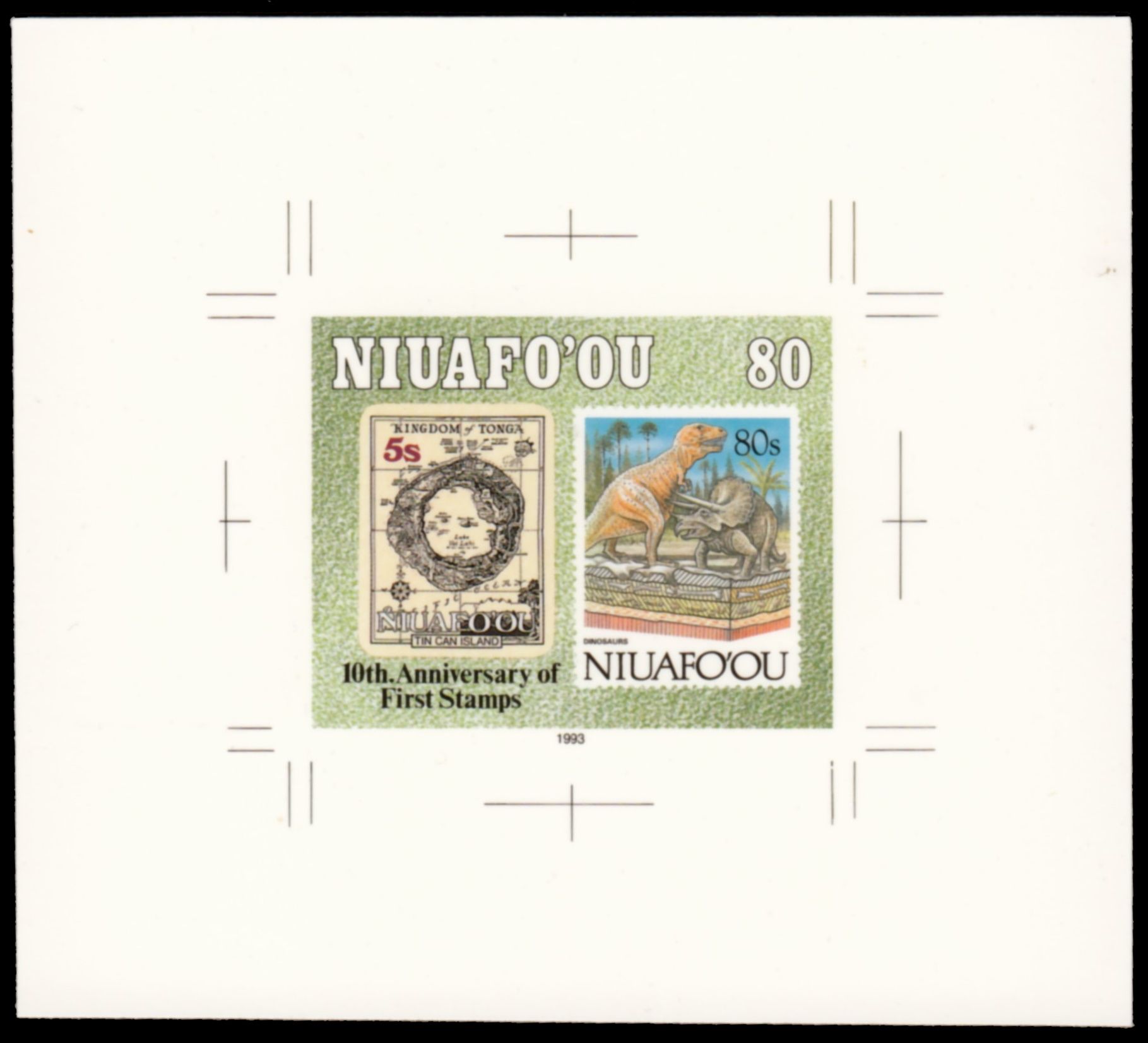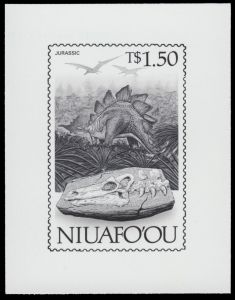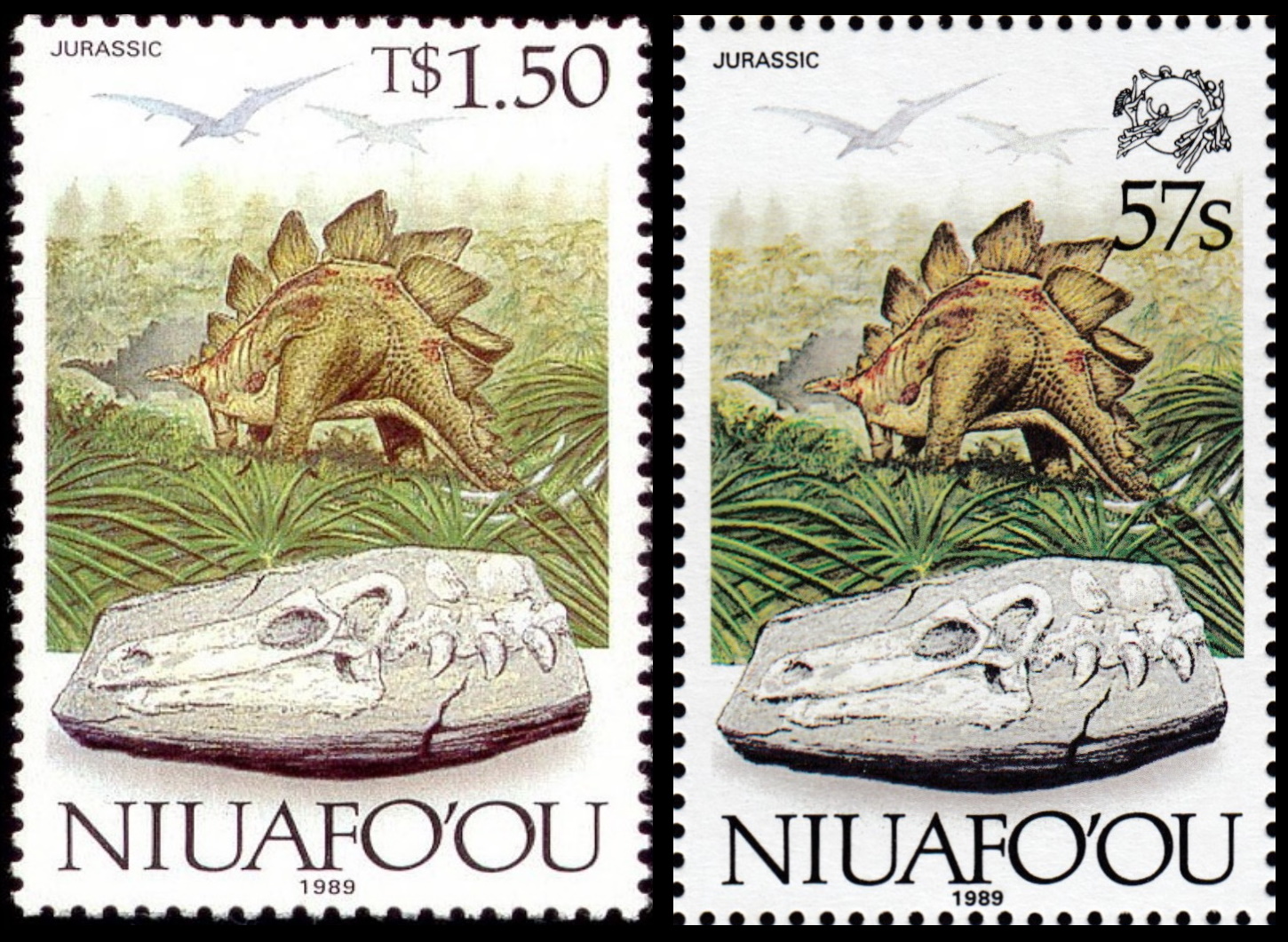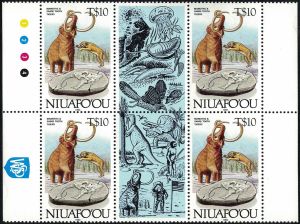the place where Paleontology and Paleoanthropology meets Philately
Niuafoʻou (Tonga)
Fossils, dinosaurs, prehistoric animals and humans on stamps and postmarks of Niuafoʻou
| << previous country | back to index | next country >> |
Contents:
- Country overview
- Philately of Niuafo'ou
- Official stamps of Niuafo'ou related to Paleontology
- Commemorative postmarks of Niuafo'ou related to Paleontology
- Some other postmarks of Niuafo'ou to consider
- References
- Acknowledgements
Niuafo'ou (meaning: many new coconuts) is the most northerly island in the kingdom of Tonga.
It is a volcanic rim island of 15 km square with a population of 650 in 2006.
Niuafo'ou was formed by submarine explosive and effusive activity during the Holocene. (The Holocene is the current geological epoch, which began approximately 11,650 years before the present).
Explosive volcanic activity - means the eruption of volcanic ash into the atmosphere, which then settles out as ash deposits around the volcano.
Effusive volcanic activity - the eruption of lava that flows down the sides of the volcano, eventually cooling to form lava flow deposits.
In 1957 about half of the population returned to Niuafo'ou, and the rest remained in 'Eua. [R1]
In world postal history, Niuafo’ou gained fame as Tin Can Island or Tin Can Mail Island.
As Niuafo'ou lacked a deep-water harbor to accommodate ships, the island was so difficult to access, no mail could be collected or delivered.
To solve the problem, William Travers, a plantation manager who settled on the island in 1882, developed the practice of tin can mail. He arranged for passing ocean going ships to sail inward bound mail in a tin can. The can would be thrown overboard and picked up by swimmers. Outward bound mail was wrapped in oil greased paper, tied to sticks and brought to the ships by swimmers.
To swim mail out, Tongans adopted the traditional fishing technique of using a buoyancy pole, called a fau, to swim out with a biscuit or kerosene tin to visiting ships. Using the pole for support the swim could take several hours. After a shark killed a Tongan swimmer in 1931, swimming was banned, and canoes had to be used instead.
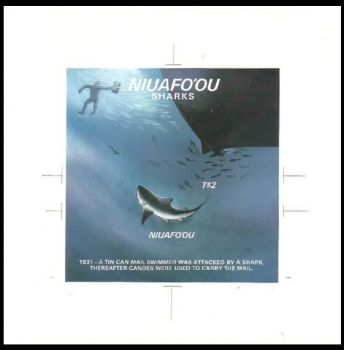 |
|
| Short video about Niuafo’ou' Postal History | Shark attack Tin Can Mail swimmer on Cromalin proof of Niuafo’ou 1987 |
The practice of tin can mail gained world fame due to the initiatives of the German trader Walter George Quesnell who settled on Niuafo’ou in 1928. He commercialized tin can mail, seeing the interest the practice might raise among stamp collectors.
Initially he applied hand stamps to outgoing letters reading ‘Tin Can Mail’. Subsequently, he arranged for passengers from passing cruise ships to be able to send him self-addressed covers to which he would apply stamps and cachets before sending them on. The practice appealed to tourists.
Soon cruise ships would stop by the island several times a week. To share in the profits, cruise ships started to apply their own cachets to covers sent to Quesnell.
The practice also appealed to stamp collectors and tin can mail covers have become collector's items.
The practice ended in 1983 after an airstrip was built. On Niuafo’ou, the stamps of Tonga were used until 1983.
Probably as compensation for the loss in income after tin can mail ended, the government of Tonga authorized Niuafo’ou to issue its own stamps under the supervision of the Postal Authorities of Tonga. The stamps issued since are aimed mainly at the thematic collectors market.
Between 1983 and 1997, stamps of Niuafo’ou were produced by Combined Philatelic Agency (CPA). Combined Philatelic Agency was run by two English stamp dealers of the time, Derek Worboys and Alan Benjamin, who also had Walsall Security Printers (WSP) of London, UK.
After initial approval for the stamp had been given by the Tongan
Postal Authority, the printers went ahead and got the inhouse artist at WSP
(Ray Edge, George Bennett and others)
to do the final artwork.
When done, the printers would reduce the size of the final artwork to a size approximately
4 times the size of the actual stamp.
This reduced size was printed on a card – a Cromalin proof.
Cromalin proofs were done by Walsall Security Printers on thick card and in full color,
a proofing method in which full color proofs are produced directly
from the color separations prior to final production of the printing plates.
Each color is layered on top of the next thus building up to the full color design.
Usually only 4 or 5 were done.
The monochrome proofs were produced, in amounts of 20, after the Cromalin one, then sent to Tonga for the officials to check.
The monochrome proofs were also sent to stamp magazines to illustrate the upcoming new issues
(Few examples: [1], [2] , [3] ).
The cromalin proofs never left the printing house in UK.
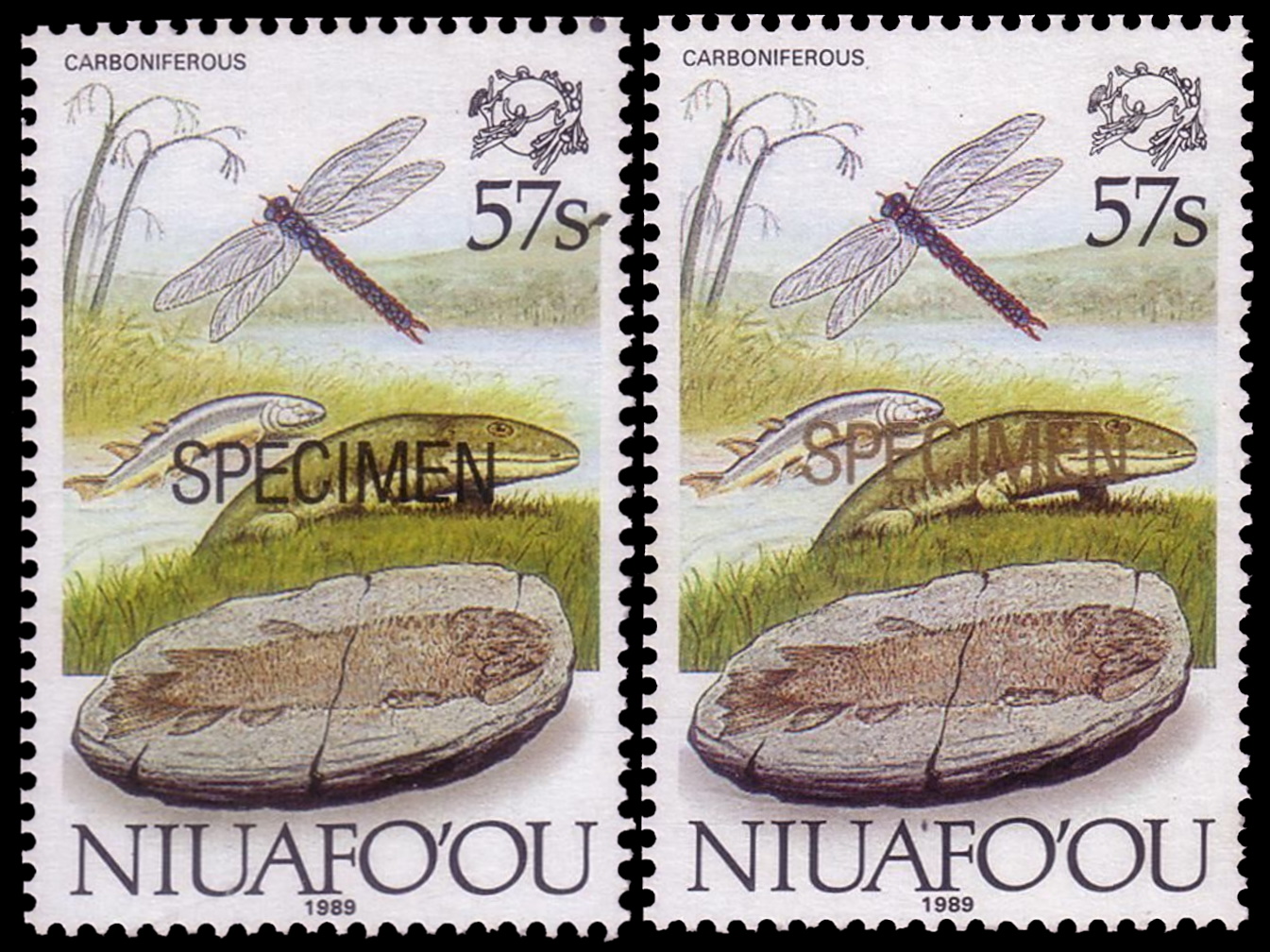
|
| Black and Gold SPECIMEN overprint on stamp from "World Stamp Expo'89: Evolution of the Earth" ^ set of Niuafo’ou 1989, MiNr.: 164, Scott: 123k |
In most of the cases, Niuafo’ou's stamps were printed in sheets of 20. The printers overprinted 10-20 sheets of stamps with the word “specimen”.
About half of these were sent onto the Philatelic Bureau in Nukualofa to give to large new issue buyers, and CPA kept about half the specimens to sell themselves. The specimens were sent to stamp magazines to advertise upcoming issues, same with dealers, and many were sent to the philatelic bureau in Nukualofa (the capital of Tonga) who gave specimen sets as gifts to some new issue buyers who purchased a larger number of sets.
Unlike other countries, Niuafo’ou (Tonga) did not print and issue imperforate stamps from 1981 onwards. All stamps were perforate (or self-adhesive). Between 1983 and 2011, Niuafo’ou issued about 20 stamps per year.
Since 2011, Niuafo’ou, as well as Tonga, have used Philatelic Collector Inc. (PCI) to print stamps on their behalf.
PCI is a stamp publishing agency based in New York. PCI prints 40-80 stamps per year on behalf of Niuafo’ou. [R2]
Official stamps of Niuafo'ou related to Paleontology: fossils, dinosaurs, prehistoric animals and humans
| 06.06.1989 "Evolution of the Earth" (I) [1] | 01.08.1989 "Evolution of the Earth" (II) [1] | 17.11.1989 "World Stamp Expo'89: Evolution of the Earth" (III) [1] |
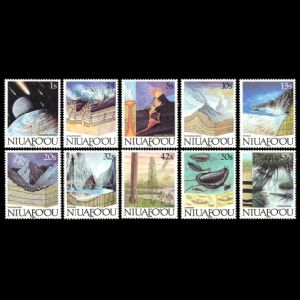 |
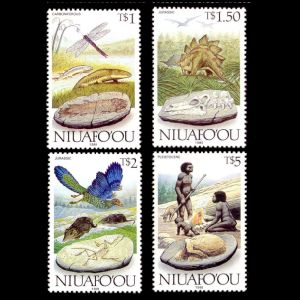 |
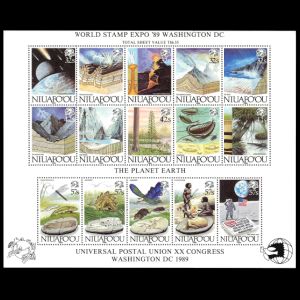 |
| 03.03.1993 "Evolution of the Earth" (IV) | 03.05.1993 "10 years of Niuafo’ou's stamps" | 14.09.1993 "Evolution of the Earth" (V) [2] |
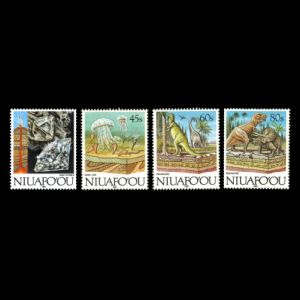 |
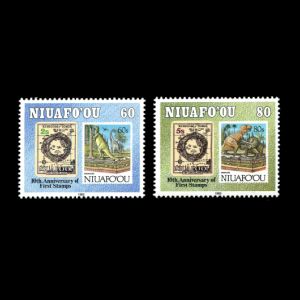 |
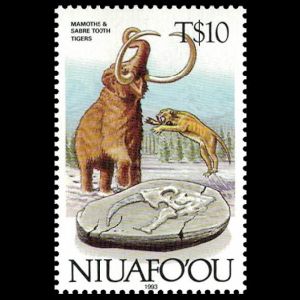
|
| 01.09.1995 "International Stamp Exhibit SINGAPORE'95" | 05.09.1996 "XIII Congress of international union of Prehistoric and Protohistoric science" [3] | |
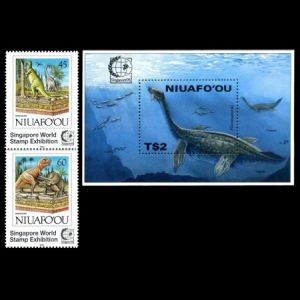 |
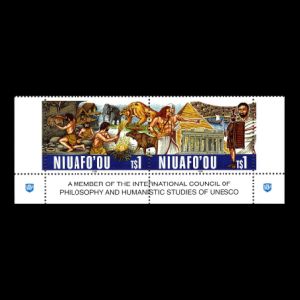 |
|
Notes:
[1] On June 6, 1989 Niuafo'ou issued a set of 10 stamps that shows "Evolution of the Earth" from creation of our planet to appearance of early life forms. Less than two months later, four more stamps of the same theme were issued.
Every stamp shows both reconstruction and a fossil of the animal.
Prior to World Stamp Expo 1989 that took place in Washington between November 24 and December 3, one more stamp of "Evolution of the Earth" issued by the island country. All 15 stamps are printed together in a mini-sheet - 3 rows, 5 stamps each.
The stamps from the Mini-Sheet can be differentiated from the previous releases by the logo of UPU on their top-right corners and the face values.
Some more stamps of the same topic issued in 1993. Four stamps issued in March have a different design, but stamp issued in September designed as stamps from 1989 - reconstruction of prehistoric animals on background and fossil on foreground.
[2] Many other prehistoric animals, same design as stamps issued between 1989 and 1993, are depicting on a label in between the mammoth stamps (see above).
[3] "Joint" issue with Tonga.

Joint issue of Tonga 1996 (MiNr.: 1429-1430, Scott: 929a-b) and Niuafo’ou (MiNr.: 303-304, Scott: 190).
Commemorative postmarks of Niuafo’ou related to Paleontology: prehistoric animals
| 14.09.1993 "Evolution of the Earth" (V) [2] | ||
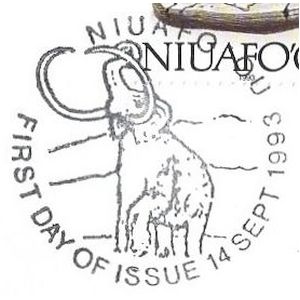 |
|
|
Commemorative postmarks of Niuafo’ou related to Paleontology: prehistoric animals
| 05.09.1996 "XIII Congress of international union of Prehistoric and Protohistoric science 1996" [3] | ||
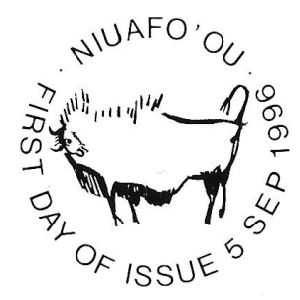 |
|
|
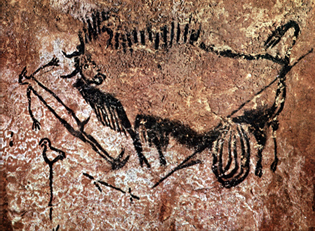
|
| The famous shaft scene of Lascaux: a man with a bird head and a bison. Image credit: Wikipedia, |
Notes:
[PMO1] A Bison from a cave painting likely from the Lascaux Cave of France - "The Bird, Man and Bison".
One of the most intriguing cave paintings is the so-called Shaft Scene of Lascaux cave,
dating from approximately 17,300 years before present, in the Dordogne region of France.
This image of the famous "Bird Man" figure, like most Palaeolithic art, defies unambiguous explanation and although
shamanic elements are clearly visible in the depiction.
The painting is located in an entirely separate part of the cave called The Shaft,
a deep natural fissure which leads to a lower level some six metres below the floor of the cave,
and which appears to function as a particularly special or hidden place within the already deeply sacred space of Lascaux.
[R3]
References:
- [R1] Niuafo'ou: Wikipedia, Smithsonian Institution,
- [R2] Postal History and Philately of Niuafo'ou:
Wikipedia,
Stamp Wolrd History
(Web-Archive, original site does not exist anymore),
"In quest for abusive and undesirable stamp issues" by Jari Majander, published in Nr. 29 (Sept2020) of TCNews (p. 24-64). - [R3] Lascaux Cave: Wikipedia, The 'Bird Man' of Lascaux.
Acknowledgments:
- Many thanks to the fellow collector Ton van Eijden, owner of stampedout - website about prehistoric life on stamps, who shared some scans from his collection.
- Many thanks to Mr. Greg Jorgensen from Australia, who sells philatelic materials from archive of Walsall Security Printers on the Internet under the nickname tonga2, for explanations about their printing process.
- Many thanks to Dr. Peter Voice from Department of Geological and Environmental Sciences, Western Michigan University, for the draft page review and his very valuable comments.
| << previous country | back to index | next country >> |
